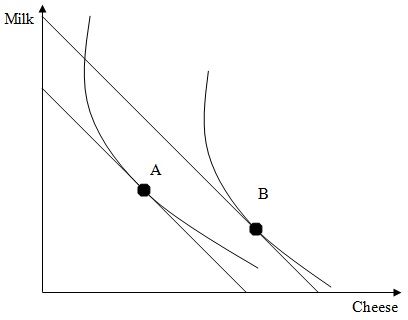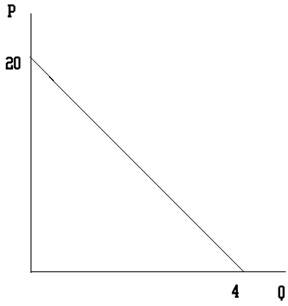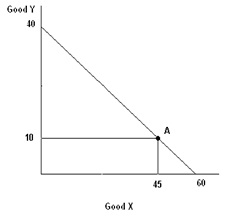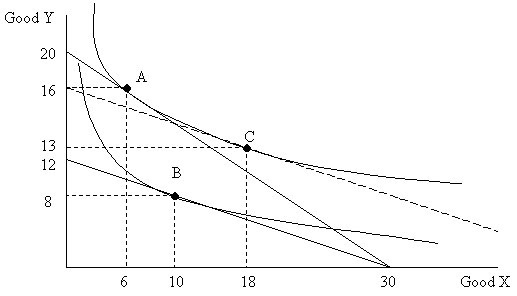I. 10 Binary Choice Questions:
Use the following information to answer the next three questions.
The following table gives the production and cost functions for a firm. L is labor; K is capital; Q is output; FC is fixed cost; VC is variable cost; and TC is total cost. Assume that labor is paid a constant wage, i.e. our firm is a price-taker in the labor market.

1. Given the above information, the price of one unit of labor is equal to
a. $3
b. $4
2. Given the above information, the average total cost of producing 20 units of output is equal to
a. $27
b. $1.55
3. Given the above information, when the firm produces 10 units of output the firm’s marginal cost is equal to
a. $1.90
b. $0.40
4. A perfectly competitive firm in the long run will produce that level of output where
a. MC equals MR equals ATC.
b. MC is minimized.
5. In the short run a perfectly competitive firm has total costs of $50 when it sells 25 units of output at a price of $3 per unit of output. In the long run
a. firms will enter this industry.
b. firms will exit this industry.
6. Assume that the inflation rate is constant and positive between 2006 and 2008. If we set 2006 as the base year, and nominal wages increase every year between 2006 and 2008, the real wage also increases between 2006 and 2008.
a. True
b. False
7. Suppose the Consumer Price Index (CPI) rose over one year from 120 to 150, while during the same period of time the nominal wage rose from $6 to $9. Then the real wage
a. rose by 20%.
b. rose by 30%.
To solve the next question use the information below:
Case1: Demand is downward sloping and supply is perfectly elastic
Case2: Demand is perfectly inelastic and supply is upward sloping
8. Given this information, which of the following statements is true?
a. In both cases the economic burden of an excise tax would fall on the consumer.
b. In terms of allocative efficiency imposing an excise tax is equivalent in both cases given the extreme elasticity of supply in Case 1 and the extreme elasticity of demand in Case 2.
9. Suppose you are given the following information about an economy. In this economy, the real wage increases 10% from 2000 and 2001. The nominal wage in this economy increased 21% from 2000 and 2001. What is the rate of inflation between 2000 and 2001?
a. 10%
b. 11%
10. The cross-price elasticity of demand between good 1 and good 2 is -0.5. Goods 1 and 2 are most likely ________.
a. Substitutes.
b. Complements.
II. 18 Multiple Choice Questions:
11. Which of the following statements is true? Assume that the basketball team is composed of a number of players of different heights.
I. If the average height of your basketball team is six feet then the addition of a new forward to your team will certainly raise the height of your team.
II. If the average height of your basketball team is six feet then the addition of a new team member will reduce the average height if the team member is less than six feet tall.
III. If the average height of your basketball team is six feet and you add a new player and the average height of the team increases this implies that the new player must be taller than the shortest person on the team.
a. Statements I, II and III are all correct statements.
b. Statements II and III are correct statements.
c. Statements I and II are correct statements.
d. Statement II is a correct statement.
12. Suppose that as the firm produces a larger quantity of the good the average cost of producing the good decreases. This implies
a. That the firm benefits from being a larger scale operation.
b. That the firm’s marginal cost curve must be less than the average cost curve at any output level within this range of outputs.
c. That the firm experiences decreasing costs as the level of output increases.
d. All of the above statements are true statements.
13. A perfectly competitive firm is earning positive economic profits in the short run. Which of the following statements is true?
I. In the long run this firm will earn zero economic profits.
II. In the long run this firm will be unwilling to produce any output unless it has positive economic profits since the firm must earn a profit in order to stay in business.
III. Entry of new firms in the long run will cause the market supply curve to shift to the right and the market price to increase for this good.
a. Statement I is correct.
b. Statement II is correct.
c. Statement III is correct.
d. Statements I and II are correct.
e. Statements I and III are correct.
14. Joe currently operates his own company. He has labor costs of $10,000 a year; capital costs of $50,000 a year and revenues of $100,000 a year. He has no other input costs but he knows that he could sell his business for $40,000 and earn a 5% return at the bank if he was to deposit this money into a certificate of deposit. In addition he knows that he could command a salary of $30,000 if he worked for someone else. Given this information
a. Joe should sell his business.
b. Joe should continue to operate his business since his accounting profits are greater than his economic profits.
c. Joe has accounting profits of $8,000.
d. Joe should continue to operate his business since his economic profits are positive.
Use the graph below to answer the next question.

15. The above picture shows the indifference curves and budget line for individual Johan. If Johan’s income increases, his optimal consumption changes from point A to point B. Which of the following statements is true?
a. Milk is a normal good.
b. Cheese is an inferior good.
c. Cheese and milk are substitutes.
d. Milk is an inferior good.
Use the information below to answer the next three questions.
Suppose that an economy is described by the following equations:
Demand: P = 100 – 3Q
Supply: P= 10
16. Given the information above, which of the following statements is true?
a. Consumer surplus is zero.
b. Producer surplus is $150 and price equals $10.
c. Producer surplus is $300 and the quantity produced is 30.
d. Producer surplus is zero given that supply is perfectly elastic.
17. Suppose the government in this economy decides to impose an excise tax of 10 dollars per unit consumed of this good. Then in this market
a. The quantity produced is 100/3, the market price of the good is $20 and the price received by the producers (Pnet) is $10.
b. The producer tax incidence is equal to zero, the consumer tax incidence is equal to $800/3, and the market price for the good is $10.
c. The quantity produced is 80/3, the market price of the good is $20 and the price received by the producers (Pnet) is $20.
d. The producer tax incidence is equal to zero, the consumer tax incidence is equal to $800/3, and the market price of the good is $20.
18. The imposition of this excise tax of $10
a. Generates a deadweight loss of $100/3 and a loss in consumer surplus of $300.
b. Generates a deadweight loss of $50/3 and a loss in consumer surplus of $850/3.
c. Generates a deadweight loss of $100/3 and a tax incidence to consumers of $800/3.
d. Generates a deadweight loss of $100/3 and a tax incidence to producers of zero.
Use the following graph to answer the next two questions

19. From the graph above one can deduce that:
a. When the price equals 15 the point elasticity of demand is equal to three and when the price is equal to 5 demand is elastic.
b. When the price equals 20 the quantity demanded is zero and therefore demand is inelastic at this point.
c. If quantity equals 4 demand is perfectly elastic since both the quantity axis and a perfectly elastic demand curve are horizontal.
d. When the price equals 15 the point elasticity of demand is equal to three and when the price is equal to 5 demand is inelastic.
20. Given the above graph, the revenue of producers is maximized when the producers charge a price of
a. P = $15
b. P = $4
c. P = $10
d. P = $5
Use the following graph to answer the next three questions.

21. If Jane has 12 dollars then the price of good Y is ____ and the price of good X is ____.
a. $0.30, $0.40
b. $0.40, $0.30
c. $0.40, $0.20
d. $0.30, $0.20
22. If point A was Jane’s optimal bundle what would Jane’s marginal rate of substitution be at that point?
a. 2/9
b. 2/3
c. 3/2
d. 9/2
23. Now suppose that point A is no longer the optimal consumption bundle and that at point A Jane’s marginal rate of substitution is 1. Jane would be sure to increase her utility by:
a. Moving a small amount along her budget line to the right, increasing consumption of good X.
b. Moving a small amount along her budget line to the left, decreasing consumption of good X.
c. Consuming 60 units of good X and 0 units of good Y.
d. Consuming 40 units of good Y and 0 units of good X.
Use the following graph to answer the next question. Note: this graph is NOT DRAWN TO SCALE.

24. From this graph we can see that good X is _______ and good Y is _________.
a. normal, normal
b. normal, inferior
c. inferior, normal
d. inferior, inferior
25. The cross-price elasticity of demand between widgets and gadgets for Samantha is negative. Suppose some gangsters damage important machines used in the production of widgets. Holding everything else constant, Samantha will
a. Pay a higher price for each gadget and will therefore consume fewer gadgets.
b. Pay a lower price for each gadget and will therefore consume more gadgets.
c. Pay a higher price for each gadget and will consume more gadgets.
d. Pay a lower price for each gadget and will consume fewer gadgets.
Use the information below to answer the next question.
The income elasticity of demand for good X is a negative number. The supply and demand for the good in this market are given by:
P=200-2Q
P=2Q
26. Suppose all individuals in the economy experience an increase in their income that shifts the demand by 60 units for every price. Then
a. The equilibrium price and quantity after the change in income are P=100 and Q=50
b. The equilibrium price and quantity after the change in income are P=70 and Q=35
c. The equilibrium price and quantity after the change in income are P=160 and Q=80
d. The equilibrium price and quantity after the change in income are P=40 and Q=20
27. Barbara decides to expand her business. She increases all of her inputs proportionately and finds that this results in her output increasing by more than the proportional increase in inputs. Barbara concludes that
a. Her business is operating in the increasing returns to scale portion of her cost curve and that her average costs are declining.
b. Her business is operating in the increasing returns to scale portion of her cost curve and that her average costs are increasing.
c. Her business is operating in the decreasing returns to scale portion of her cost curve and that her average costs are declining.
d. Her business is operating in the decreasing returns to scale portion of her cost curved and that her average costs are increasing.
28. Which of the following statements are true about the income and substitution effects?
I. The substitution effect measures the effect of a change in the relative price of two goods on a consumer’s consumption choice while holding constant the consumer’s level of satisfaction.
II. The income effect measures the effect of an increase in a consumer’s nominal income on their purchases of the two available goods.
III. The income effect addresses the loss in purchasing power that occurs when the price of one of the goods decreases while holding income and the price of the other good constant.
a. Statement I is true.
b. Statements I and II are true.
c. Statements I and III are true.
d. Statements I, II and III are true.
III. 2 Problems
General Instructions: Please place a box around each of your answers so that your answers are easier for the grader to find. Please work in a logical, orderly fashion. Please show all your work to receive full credit.
1. You are given the following information about Paul. Paul has a weekly income of $100 and he purchases only two goods: bananas and steak. The price of a banana is $2 and the price of a steak is $5.
a. Given the above information draw Paul’s budget line measuring bananas on the x-axis and steak on the y-axis. In your graph make sure you label the intercepts of the budget line and the axes.
b. Given the above information Paul wishes to maximize his satisfaction subject to the constraint imposed by his income and the prices of the two goods. Examine each of the following combinations and explain why Paul either might choose to consume this combination of the two goods or might not choose to consume this combination of the two goods. Assume Paul has normal indifference curves.
i. (45 bananas, 2 steaks)
ii. (5 bananas, 19 steaks)
Suppose you are told that Paul chooses to consume 25 bananas and 10 steaks given his income and the initial prices of the two goods.
c. Suppose that the price of bananas increases to $5. Paul’s income and the price of steaks do not change. Furthermore, you are told that Paul now chooses to consume 10 bananas and 10 steaks. Draw a diagram representing Paul’s initial optimal consumption choice (point A) and his initial budget line (BL1) and Paul’s new optimal consumption choice (point B) and his new budget line (BL2). Label the graph carefully and completely: make sure both axes are labeled and that the intercepts for both budget lines are labeled. Also, make sure that points A and B are marked and labeled.
d. Using the information given in this problem, draw Paul’s demand curve for bananas making sure you identify two points numerically on this demand curve by referencing the price and quantity associated with each point.
2. The market for good X is described by the following equations:
Supply: P=2Q
Demand: P=100-(Q/2)
a. Find the equilibrium price and quantity in this market.
b. Suppose the government decides to implement an excise tax of 20 dollars per unit produced. Assume this excise tax is levied on producers of the good. Find the new equilibrium price and quantity in the market and the net price received by the producers (Pnet) once the excise tax has been paid to the government.
c. Draw a graph illustrating this excise tax. On your graph label the areas that correspond to consumer tax incidence (CTI), producer tax incidence (PTI), consumer surplus with the tax (CS tax), producer surplus with the tax (PS tax), and deadweight loss (DWL). Be sure to include in your graph all the values found in parts (a) and (b).
d. Who bears a greater economic burden when this excise tax is imposed? Explain your answer.